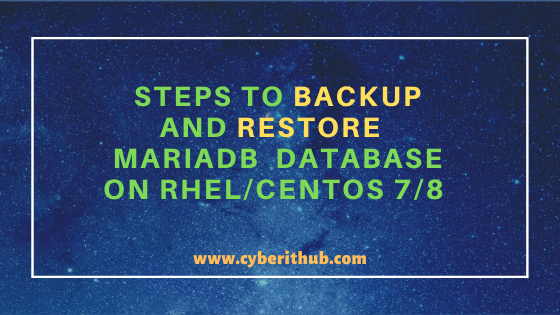Table of Contents
Do you want to know the steps to Backup and Restore MariaDB Database on RHEL/CentOS 7/8 ? If yes, then you have come to the right place. If you are using MariaDB Database in your Organization then it is very important for you to understand how to take backup and restore mariadb data. There are usually two types of backup that can be taken – Full Backup and Incremental Backup. In this tutorial we are going to look into the steps to backup and restore mariadb from full backup data.
Though there are multiple tools that can be used for backup and restoration but we are going to use mysqldump to dump the MariaDB database data and mysql to restore mariadb data. You can check more about MariaDB Backup and Restore on Official Website.

Steps to Backup and Restore MariaDB Database on RHEL/CentOS 7/8
Also Read: 6 Simple Steps to Change/Reset MariaDB root Password on RHEL/CentOS 7/8
Step 1: Backup MariaDB Database using mysqldump tool
MariaDB comes with an inbuilt tool called mysqldump which can be used to take the dump of single database or multiple databases as per the requirements. Here we are going to use this tool to take the backup of our Sample database cyberithub which we will later restore in our destination MariaDB Server using mysql tool. To take the backup of cyberithub database you need to use mysqldump -u root -p cyberithub > cyberithub.sql command as shown below. This command will dump all the tables and its data of cyberithub database into cyberithub.sql file.
[root@localhost ~]# mysqldump -u root -p cyberithub > cyberithub.sql Enter password:
-u : User Name
-p : Password
After taking the dump if you check the size of the backup using du -sh cyberithub.sql then it will show size around 20K as shown below.
[root@localhost ~]# du -sh cyberithub.sql 20K cyberithub.sql
NOTE:
root user to run all the below commands. You can use any user with sudo access to run all these commands. For more information Please check Step by Step: How to Add User to Sudoers to provide sudo access to the User.Step 2: Create a Database to Restore the Data
Before restoring the data you need to first create a database in MariaDB as described below. First you need to login to MariaDB through root user using mysql -u root -p command and then run create database cyberithub query to create a database cyberithub as shown below. Then to verify the database creation you can run another query show databases and then exit the prompt by using exit query.
[root@localhost ~]# mysql -u root -p Enter password: Welcome to the MariaDB monitor. Commands end with ; or \g. Your MariaDB connection id is 11 Server version: 5.5.65-MariaDB MariaDB Server Copyright (c) 2000, 2018, Oracle, MariaDB Corporation Ab and others. Type 'help;' or '\h' for help. Type '\c' to clear the current input statement. MariaDB [(none)]> create database cyberithub; Query OK, 1 row affected (0.01 sec) MariaDB [(none)]> show databases; +--------------------+ | Database | +--------------------+ | information_schema | | cyberithub | | mysql | | performance_schema | +--------------------+ 4 rows in set (0.00 sec) MariaDB [(none)]>
Step 3: Restore MariaDB Database Using mysql tool
Once database is created, you can restore all the backup into that database by using mysql -u root -p cyberithub < cyberithub.sql command as shown below. Here we are restoring all the data of cyberithub.sql dump file into cyberithub database through root user.
[root@localhost ~]# mysql -u root -p cyberithub < cyberithub.sql Enter password:
Step 4: Check Your Restored Data
If all goes well then data will be restored and available for use. You can again login to MariaDB using mysql -u root -p command and check all the tables in cyberithub database as shown below.
[root@localhost ~]# mysql -u root -p Enter password: Welcome to the MariaDB monitor. Commands end with ; or \g. Your MariaDB connection id is 13 Server version: 5.5.65-MariaDB MariaDB Server Copyright (c) 2000, 2018, Oracle, MariaDB Corporation Ab and others. Type 'help;' or '\h' for help. Type '\c' to clear the current input statement. MariaDB [(none)]> show databases; +--------------------+ | Database | +--------------------+ | information_schema | | cyberithub | | mysql | | performance_schema | +--------------------+ 4 rows in set (0.00 sec) MariaDB [(none)]> use cyberithub; Reading table information for completion of table and column names You can turn off this feature to get a quicker startup with -A Database changed MariaDB [cyberithub]> show tables; +-----------------------+ | Tables_in_cyberithub | +-----------------------+ | customerlist | | Phone | | installlist | | Product | | Account | | Address | | users | +-----------------------+ 7 rows in set (0.00 sec) MariaDB [cyberithub]>
Popular Recommendations:-
Step by Step Guide to Install Apache 2.4.6 Web Server on RHEL/CentOS 7
How to Install MariaDB 5.5 Server on RHEL/CentOS 7 Linux with Easy Steps
Best Steps to Install Java on RHEL 8/CentOS 8
5 Examples to Turn Off SELinux Temporarily or Permanently on RHEL 8/CentOS 8
Best Explanation of Wrapper Classes in Java: Autoboxing and Unboxing with Examples
5 Best Ways to Become root user or Superuser in Linux (RHEL/CentOS/Ubuntu)
